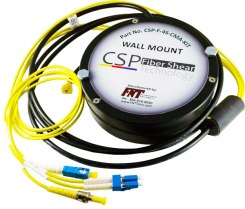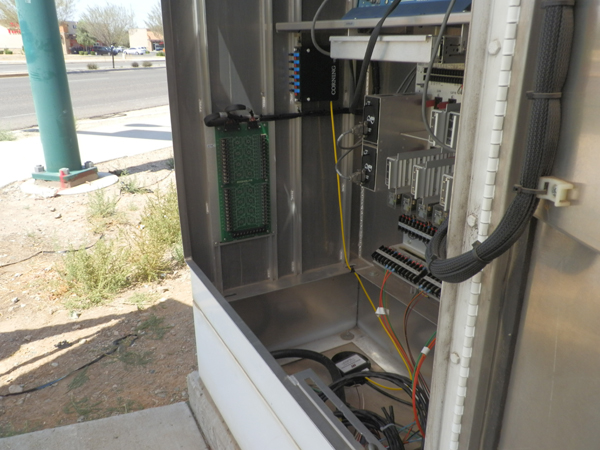Many Department of Transportation (DOT) Divisions across the country and around the world have standardized on a fiber optic connectivity system within their traffic cabinets that include a means for indirect connections to valuable equipment and instruments. This methodology is based on known and adopted Standards for interfacing to premise (indoor) routers, hubs, switches and light interface units. The process includes the use of an outdoor to indoor interface panel, commonly referred to as an LIU, where outdoor rated cable coming into the cabinet is terminated and then is cross-connected to the equipment within the cabinet using conventional indoor rated patch cables. The problems associated with the current design model can easily be quantified by several years of maintenance data on traffic cabinets.
Ambient Conditions and the Effects on Cross-Connects in Traffic Cabinets
Let’s first consider the issue associated with how fiber itself works. Optical Engineers understand that the most vulnerable point of a fiber circuit is found at the end of the glass where the connector is located. Mated connectors, contrary to popular belief, are not sealed connections and are often subject to gathering and harboring dust, humidity born water and other forms of contamination. Traffic Engineers spend a great deal of time and effort developing requirements for issues such as “loss not to exceed” and so on, but often overlook the fact that their maximum specified loss is only good the day that the fiber was installed and tested. From that point on, the fiber circuit and its associated loss will continue to degrade year-by-year, depending on ambient conditions and the number of coupled connections exposed to those conditions. Compounding the effects of this problem, most transportation groups exclusively use singlemode fiber due to the extended transmission distances that they deal with. Unlike the more contamination forgiving multimode fiber, singlemode fiber has a very small core, which can be completely blocked at the connector interface by a single spec of airborne dust. This contributes to significant add-ons to annual preventive maintenance costs.
Where cabinet fiber optic cross-connects are applied, the connectivity components specified are often consisted of a commercial, off the shelf variety. Commercial grade fiber optic connection components, whether made on or off-shore, are comprised of multiple dissimilar material components that, when assembled will expand and contract with temperature at different rates. This causes movement between the joined connectors at different times of the day. On singlemode circuits, with a very small transmission core, this can lead to intermittent or even total dropout of a signal depending on the amount of joined connector movement, combined with the effects of advanced levels of connector end-face contamination. Another consideration is that cross-connect patch cables are often indoor rated. The bottom line is that many of these commercial, off the shelf, singlemode components are simply not designed for the rigors and hazardous duty aspects of outdoor traffic cabinet applications. It is interesting to look inside a traffic cabinet and see the extreme difference in requirements from copper to fiber. We pay a great deal of attention to the requirements for hardened and hazardous duty electronics that are ultimately connected to an inferior non-hazardous duty cable design. When you look at copper cabling harnesses and connectivity devices inside traffic cabinets, you often see rugged military grade pin and socket interfaces that are specifically designed for hazardous duty outdoor use. As the amount of fiber optic cabling to traffic cabinets continues to increase and the bandwidth requirements continue to grow, the current methodology of terminating fiber in traffic cabinets will have to change.
Direct Connect and Protect Cabling Infrastructure Protection
With that in mind, consider the possibility of removing all evidence of contamination prone cross-connects within traffic cabinets and replacing them with a direct connection concept. Consider not just using hardened switches, but using hardened fiber optic connectivity components. The U.S. Military learned a long time ago that the ruggedness of the interface cabling is every bit as important as the ruggedness of the electronics that it connects to.
 In the late 2000s, FNT was instrumental in bringing the Intelligent Release Interconnect System (IRIS) to market. The IRIS connector is made from military inspired technology. The connectors are aligned within a pin and socket all steel body offering a rugged design that can withstand the weight and force of a tank. More importantly, it’s the military attention to detail to minimize issues such as dust, mud, water, chemicals and corrosive sprays. The precision connector mating ability and holding of proper alignment under the most severe conditions on a military inspired connector is truly remarkable. While IRIS is superior to any device on the market, this level of protection is just not required in standard traffic cabinets.
In the late 2000s, FNT was instrumental in bringing the Intelligent Release Interconnect System (IRIS) to market. The IRIS connector is made from military inspired technology. The connectors are aligned within a pin and socket all steel body offering a rugged design that can withstand the weight and force of a tank. More importantly, it’s the military attention to detail to minimize issues such as dust, mud, water, chemicals and corrosive sprays. The precision connector mating ability and holding of proper alignment under the most severe conditions on a military inspired connector is truly remarkable. While IRIS is superior to any device on the market, this level of protection is just not required in standard traffic cabinets.
 In 2016, FNT introduced CSP Fiber Shear Technology, offering the same superior protection and quick restoration as IRIS, at a fraction of the cost. CSP Fiber Shear Technology does away with the concept of the cross-connect and any patch cables or components associated with current technologies. This fiber optic cabinet termination device works by offering a controlled and effective shear (clean-cut) point of the fiber itself in the event that the cabinet is struck. The shell design of the CSP Fiber Shear is nearly indestructible, water and dust proof and offers up to a 12 fiber splice chamber to perform pigtail fusion splicing, as well as emergency re-splice capability in the event of an incident. FNTs CSP Fiber Shear offers a solution to the existing problems associated with cross-connect technology, eliminating half of the maintenance prone connections per circuit for each cabinet. It can be easily retrofitted to existing circuits in a matter of minutes. With CSP Fiber Shears direct connection, Traffic Engineers will be able to run higher bandwidths with far less circuit maintenance than ever before.
In 2016, FNT introduced CSP Fiber Shear Technology, offering the same superior protection and quick restoration as IRIS, at a fraction of the cost. CSP Fiber Shear Technology does away with the concept of the cross-connect and any patch cables or components associated with current technologies. This fiber optic cabinet termination device works by offering a controlled and effective shear (clean-cut) point of the fiber itself in the event that the cabinet is struck. The shell design of the CSP Fiber Shear is nearly indestructible, water and dust proof and offers up to a 12 fiber splice chamber to perform pigtail fusion splicing, as well as emergency re-splice capability in the event of an incident. FNTs CSP Fiber Shear offers a solution to the existing problems associated with cross-connect technology, eliminating half of the maintenance prone connections per circuit for each cabinet. It can be easily retrofitted to existing circuits in a matter of minutes. With CSP Fiber Shears direct connection, Traffic Engineers will be able to run higher bandwidths with far less circuit maintenance than ever before.
FNT Tools developed CSP Fiber Shear Technology specifically for the Department of Transportation to reduce initial and on-going maintenance costs, assist with Traffic Incident Management (TIM), and protect cabling infrastructure while offering quick restoration in the event of an incident. For additional information or to schedule a demonstration, please contact FNT Fiber Network Tools toll-free at 866-818-8050 or email marketing@fibernetworktools.com.
